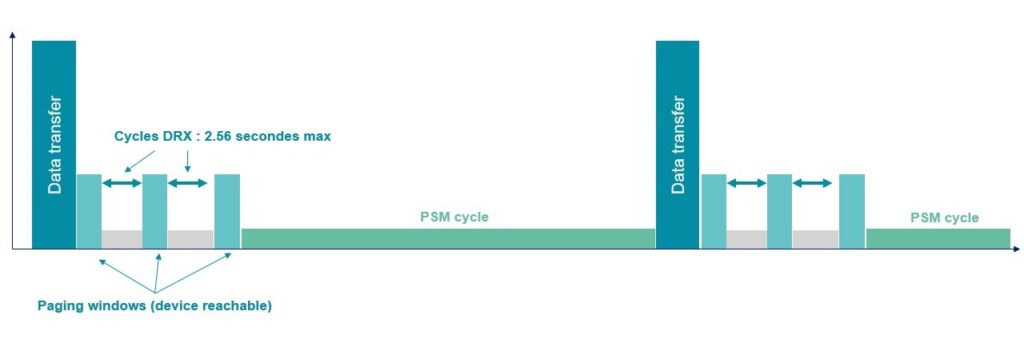If your IoT device must live on battery power for a long duration, the modem’s energy consumption is a major challenge to avoid loss of service and avoid maintenance interventions.
Ideally, the battery should even last for the device’s total lifetime while not increasing the cost of the equipment.
For this purpose, new technologies have been developed on both the network and modem side.
- Modem manufacturers have designed models capable of going into prolonged standby, only waking up at a reduced frequency to connect to the network and exchange information. These are features like PSM and eDRX.
- Mobile carriers have implemented new networks (licensed, or sometimes on free frequencies) called Low Power Wide Area Network (LPWAN), requiring less energy from the device. They are also designed for a better penetration, which means the signal can more easily go through walls, and even reach underground. Carries have specifically chosen low frequency to maximize this effect. For licensed cellular networks, it’s technologies such as LTE-M and NB-IoT.
To get all the benefits of these new technologies, you must make sure that all the boxes are ticked.
Let’s say you want to deploy a fleet of sensors equipped with LTE-M modems with eDRX and PSM features. Your mobile operator must:
- Offer LTE-M coverage
- Be compatible with PSM & eDRX modes
If you have LTE coverage with your carrier, that does not mean that LTE-M is enabled. It is not available by default in an operator’s classic LTE coverage, they must deploy the service.
Also, if you do have LTE-M coverage with your operator, your IoT Gateway may not have energy saving features like PSM & eDRX enabled.
Therefore, you need to be sure that both your mobile carrier and your modem provider are meeting the requirements!
Low Power Wide Area Networks in IoT Cellular Connectivity
There are two mobile technologies for IoT enable energy savings, namely NB-IoT and LTE-M (also called LTE Cat-M1).
Currently, these two technologies are being deployed by carriers worldwide, and there isn’t a more popular one at global level. Some countries have started deploying both, but others (in Asia notably) have chosen to focus on NB-IoT only. In parallel, modem manufacturers are selling some models only compatible with either LTE-M or NB-IoT, and sometimes with both.
The two technologies have big differences, and each has its own advantages and drawbacks.
LTE-M
As its name gives away, it is based on LTE. Its main advantages are:
- High reactivity (low latency) and a much higher bandwidth than NB-IoT (up to 1MB/s, vs 128KB/s max NB-IoT
- SMS compatible, and on some carrier, even VoLTE compatible (voice calls)
- Roaming is possible with the carriers’ existing agreements – which means that operators can easily deploy a worldwide coverage.
- No loss of connection (of the ongoing data session) if the connected object moves and attaches to a different antenna.
All of this makes it’s a great solution, and quite economical if your device:
- Is moving
- And/or requires sending data at a high frequency
- And/or must transmit data that is not simple/short meter readings
NB-IoT
This technology has more limitations, but at the same time they provide quite advantageous benefits:
- An NB-IoT module requires even less energy than an LTE-M one
- The reach of the wavelength is better than LTE-M’s, including inside buildings
- A very high number of devices (up to hundreds of thousands in a single cell!) – limiting issues liked to network saturation in use-cases with a high density of devices in the same area.
- It lowers the cost of the device, as NB-IoT modules are even less expensive than LTE-Ms.
Its limitations :
- Loss of connection if the device is moving
- Very limited bandwidth (128Kb/s)
- No voice or SMS service
- International roaming is harder to implement for most carriers
- High heterogeneity in NB-IoT implementation by the carriers, who enable or not some features that can optimize energetic consumption (No IP mode…)
Advanced standby modes of IoT modems
Low power modems compatible with NB-IoT and LTE-M possess two advanced standby modes that can further reduce the energy consumption of the device.
They both aim at controlling – and extending – the time intervals during which the device can go in standby before it wakes up again and listens to the network.
They can even be used simultaneously to lower even further the energy consumption.
These settings are configured on the device – providing of course that the network (NB-IoT or LTE-M) of the carrier is compatible.
LTE eDRX
The eDRX mode (Extended Discontinuous Reception), is an evolution of the DRX protocol, a mode enabling devices connected to an LTE network to go into periodical standby instead of continuously staying active and listening to the network.
The DRX standard is already in use by our LTE smartphones, which allows them to be listening “only” every 2.56 seconds, instead of staying forever active and waiting for traffic.
The eDRX standard increases this time by a thousand, up to 43 minutes.
The duration of these standby intervals is configured at device level, and the device itself informs the network of this frequency, so that the network lets it stay connected.
The graph below shows how eDRX can reduce the active time, and therefore the energy consumption.
After having transmitted its data, the device monitors the network for short periods (paging windows), waiting for potential incoming traffic, and the eDRX extends the duration between these periods:

The eDRX mode used alone can considerably reduce the energy consumption of the device, while keeping it quite reachable – the device will always have a paging window at least every 43 minutes.
PSM
The Power Saving Mode goes even further, enabling the device to hibernate for periods from 4h to up to 412 days!
When the device wakes (based on a timer or an internal rule), it will reconnect to the network, transmit its data, then stays reachable for a few paging windows (based on the DRX cycles explained above)
The following graph shows:
- The transmission periods
- The paging windows during which the device is listening – separated by DRX cycles
- Then it goes into Power Saving Mode, before waking up, and the cycle repeats

This mode is therefore recommended is the device does not have to be reachable quickly. By setting long sleeping periods, a couple of AA batteries can grant up to 10 years of autonomy to a device!
eDRX combine with PSM
By combining eDRX and PSM, the energy consumption is reduced at its lowest level – but be careful about the configuration! You must ensure that the PSM timer and the duration of the eDRX cycles are aligned, otherwise there will be no connection!
This graph shows the two modes working together:
The device wakes up, transmits its data, then listens for a few paging windows based on its eDRX settings, before going into Power Saving Mode, until the next wake up period.

Transatel’s offers for NB-IoT and LTE-M
Check this page to find out all the destinations where we offer LPWAN coverage.
For further details, book a free 30 minutes with one of our IoT experts to know everything on PSM & eDRX CLICK HERE






